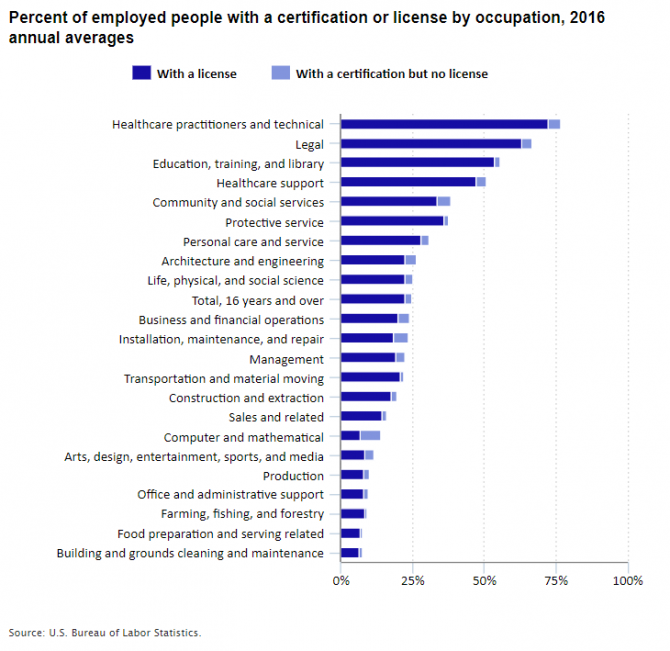Whether you are an aspiring doctor or lawyer, teacher or barber, chances are you need a license to legally work. Or you may already have a license and are now rushing to get your continuing professional education courses done before the end of the year! Whatever your status, what does BLS know about certifications and licenses and how can the information help?
While BLS and other federal statistical agencies have long produced data on educational attainment, there used to be few public sources of information on nondegree credentials like certifications and licenses. To meet this need, BLS added new questions to the Current Population Survey, the national household survey best known as the source of the official unemployment rate, back in 2015. These data help researchers, policymakers, business owners, workers, and jobseekers better understand how holding a certification or license relates to employment, unemployment, and earnings.
At BLS, we define certifications and licenses as nondegree credentials that show the holder has the skill or knowledge needed to perform a specific job. Certifications come from a nongovernmental body, such as a professional or industry organization. Licenses come from a government agency and show a legal permission to work in an occupation.
In 2016, about 44.5 million people (almost the number of people who live in Spain) held a currently active professional certification or license. People with a certification or license had an unemployment rate of 2.5 percent, compared with 5.6 percent for people without one of these credentials. One-fourth of the employed held a certification or license in 2016.
The prevalence of certifications and licenses varies by a worker’s occupation. In 2016, there were four occupation groups where more than half of workers held a certification or license: healthcare practitioners and technical occupations (77.0 percent); legal occupations (66.8 percent); education, training, and library occupations (55.5 percent); and healthcare support occupations (50.9 percent).

Editor’s note: Data for this chart are available in the table below.
We also have information on how much workers with or without a certification or license earn. In 2016, the median weekly earnings of full-time wage and salary workers with a certification or license was $1,032—35 percent higher than the median for workers without a certification or license ($765). These broad comparisons do not account for other important reasons that may explain differences in earnings, such as educational attainment and a worker’s specific job roles and responsibilities.
Whether you are a jobseeker, business owner, policy maker, or researcher, BLS data on professional certifications and licenses help you understand the important role that these credentials play in the U.S. labor market.
| Occupation | With a license | With a certification but no license |
|---|---|---|
| Healthcare practitioners and technical | 72.6% | 4.4% |
| Legal | 63.4 | 3.4 |
| Education, training, and library | 53.6 | 1.9 |
| Healthcare support | 47.2 | 3.6 |
| Community and social services | 33.5 | 5.0 |
| Protective service | 36.1 | 1.6 |
| Personal care and service | 27.9 | 3.1 |
| Architecture and engineering | 22.4 | 4.0 |
| Life, physical, and social science | 22.3 | 3.1 |
| Total, 16 years and over | 22.3 | 2.7 |
| Business and financial operations | 20.0 | 4.0 |
| Installation, maintenance, and repair | 18.3 | 5.3 |
| Management | 19.3 | 3.2 |
| Transportation and material moving | 20.7 | 1.5 |
| Construction and extraction | 17.5 | 2.2 |
| Sales and related | 14.3 | 1.8 |
| Computer and mathematical | 6.8 | 7.4 |
| Arts, design, entertainment, sports, and media | 8.5 | 3.1 |
| Production | 8.0 | 2.2 |
| Office and administrative support | 8.2 | 1.4 |
| Farming, fishing, and forestry | 8.3 | 0.8 |
| Food preparation and serving related | 6.7 | 1.0 |
| Building and grounds cleaning and maintenance | 6.5 | 1.1 |
 United States Department of Labor
United States Department of Labor